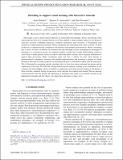Files in this item
Sketching to support visual learning with interactive tutorials
Item metadata
| dc.contributor.author | Kohnle, Antje | |
| dc.contributor.author | Ainsworth, Shaaron | |
| dc.contributor.author | Passante, Gina | |
| dc.date.accessioned | 2021-01-08T17:30:01Z | |
| dc.date.available | 2021-01-08T17:30:01Z | |
| dc.date.issued | 2020-12 | |
| dc.identifier | 265382027 | |
| dc.identifier | 95261ab5-b1f8-443c-b51f-14d1c8e8d4a1 | |
| dc.identifier | 000595863200003 | |
| dc.identifier | 85099333920 | |
| dc.identifier.citation | Kohnle , A , Ainsworth , S & Passante , G 2020 , ' Sketching to support visual learning with interactive tutorials ' , Physical Review Physics Education Research , vol. 16 , no. 2 , 020139 . https://doi.org/10.1103/PhysRevPhysEducRes.16.020139 | en |
| dc.identifier.issn | 2469-9896 | |
| dc.identifier.other | ORCID: /0000-0003-2638-4826/work/86537229 | |
| dc.identifier.uri | https://hdl.handle.net/10023/21249 | |
| dc.description.abstract | [This paper is part of the Focused Collection on Curriculum Development: Theory into Design.] This manuscript discusses how learning theories have been applied to shape multiple aspects of the design of curricular activities combining interactive computer simulations and University of Washington style tutorials (so-called simulation-tutorials). When considering the curriculum goals (what to teach), we drew on theories of representational competence and learning with multiple representations. When considering how to teach, we drew on theories of constructivism and sketching to learn, leveraging the advantages of sketching as a constructive process that requires students to make their current understanding explicit in visual form, to make specific choices in order to make their ideas concrete, and to organize information to support deep processing. When considering when and why to sketch, we drew upon theories of representational competence, learning with multiple representations and inventing to prepare for future learning to describe six distinct purposes of sketching both prior to and while working with the simulation. This is illustrated by presenting specific sketching tasks to show how theory informed the design and the sequencing of the tasks. We followed a design-based research method, working at two institutions in two countries and with multiple cohorts of students to understand, and where necessary improve, the design of these activities, primarily basing our decisions on the sketches that students had created. The key message of this research is that the design and sequencing of sketching tasks needs to be carefully matched to the pedagogical rationale and that theory can shape these decisions in many ways. | |
| dc.format.extent | 21 | |
| dc.format.extent | 2491754 | |
| dc.language.iso | eng | |
| dc.relation.ispartof | Physical Review Physics Education Research | en |
| dc.subject | LB Theory and practice of education | en |
| dc.subject | QC Physics | en |
| dc.subject | T-NDAS | en |
| dc.subject.lcc | LB | en |
| dc.subject.lcc | QC | en |
| dc.title | Sketching to support visual learning with interactive tutorials | en |
| dc.type | Journal article | en |
| dc.contributor.institution | University of St Andrews. Centre for Higher Education Research | en |
| dc.contributor.institution | University of St Andrews. School of Physics and Astronomy | en |
| dc.identifier.doi | 10.1103/PhysRevPhysEducRes.16.020139 | |
| dc.description.status | Peer reviewed | en |
| dc.identifier.url | https://journals.aps.org/prper/collections/curriculum-development-theory-into-design | en |
This item appears in the following Collection(s)
Items in the St Andrews Research Repository are protected by copyright, with all rights reserved, unless otherwise indicated.

